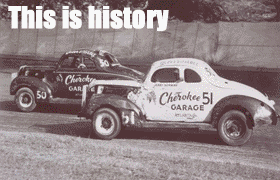
The 2011 Georgia Racing Hall of Fame inductees are, left to right, George Elliott, Mike Head, Harold Kite, Swayne Pritchett and Ken Ragan.
The votes have been tallied, and the five inductees for 2011 into the Georgia Racing Hall of Fame have been chosen.
The 2011 inductees are George Elliott of Dawsonville, Mike Head of Ellenwood, Harold Kite of College Park, Swayne Pritchett of Baldwin and Ken Ragan of Unadilla.
The 2011 Georgia Racing Hall of Fame Induction banquet will be held on Oct. 21, 2011 at 6 pm at the Georgia Racing Hall of Fame, located inside the Dawsonville Municipal Complex in Dawsonville, Georgia.
A limited number of seats for the banquet are available. Reservations are required to attend. For information on purchasing a ticket or on the banquet, call the Hall of Fame at (706) 216-RACE (7223) or go online to www.georgiaracinghof.com.
Here’s a closer look at the five inductees into the Georgia Racing Hall of Fame for 2011:
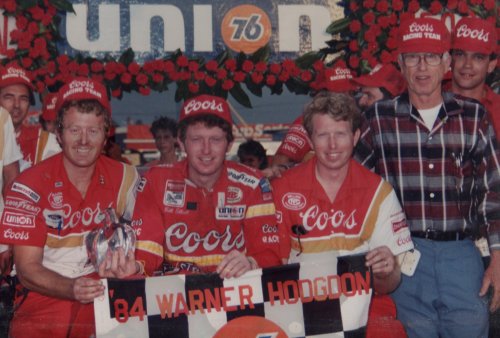
George Elliott, pictured right, celebrates a victory at Rockingham in 1984 with, left to right, sons Dan Elliott, Bill Elliott and Ernie Elliott. Photo courtesy GRHOF
George Elliott, of Dawsonville, Georgia was born April 7, 1924 in Dawsonville. While he may be best known as the father of NASCAR champion brothers Bill, Ernie and Dan Elliott and the grandfather to up and coming stock car racer Chase Elliott, those who knew him say he was the epitome of a hard worker and a fine gentleman. George owned a Ford dealership and a speed shop, and from that worked his way into racing.
Elliott fielded cars for Dan Lingerfelt and Aaron Gaily, picking up wins in the NASCAR sportsman division in the late 1960s, including a major win at Atlanta’s Lakewood Speedway, where Lingerfelt bested great racers such as T.C. Hunt, Joe Lee Johnson, Curtis Turner and “Tiger Tom” Pistone.
Elliott would celebrate many times with his drivers in victory lane, and was well known for working barefoot in the pits.
His first stint into what is now known as Sprint Cup racing came in 1966, when Don Tilley drove his #53 Ford to a 42nd place effort. Elliott’s next attempt in NASCAR’s top league came in 1971, when Clermont, Georgia’s Harry Gailey drive Elliott’s #94 Ford to a 31st place finish at Talladega. The #94 would later be used by George’s late grandson, Casey and by his son Bill.
George’s next big push into NASCAR was in 1971, with four races in the #09 with fellow Georgia native Charles Barrett behind the wheel and one event driven by Georgia Racing Hall of Fame member Jody Ridley. Various other drivers would pilot Elliott’s cars over the next few years, including A.J. Reno, former Formula 1 and sports car star David Hobbs and World Champion sports car ace Al Holbert.
In 1976, George’s son Bill would take his first shot at NASCAR’s top division driving for his father at Rockingham. He piloted a powder blue #9 Ford to a 33rd place finish after his run was foiled by a faulty fuel pump (that car today resides in the Georgia Racing Hall of Fame). With son Bill behind the wheel and sons Ernie and Dan on the pit crew, George’s team would compete sporadically over the next few seasons, often showing promise, including a second at Darlington in 1981 behind NASCAR Hall of Fame member David Pearson. In all, George’s cars would compete in 54 events from 1977-1981, recording two top fives and 23 top ten finishes, along with one pole at Darlington in 1981.
After 1981, George sold his team to Harry Melling, and the rest is history. His sons would go on to become one of the most successful families in the sport of stock car racing. All the while, he continued to serve as the family patriarch. No matter if it was a short track event or the Daytona 500, George was always there to support his family.
George Elliott passed away in September of 1998. But the legacy left behind is one that can be seen written clearly on the walls of the Georgia Racing Hall of Fame.
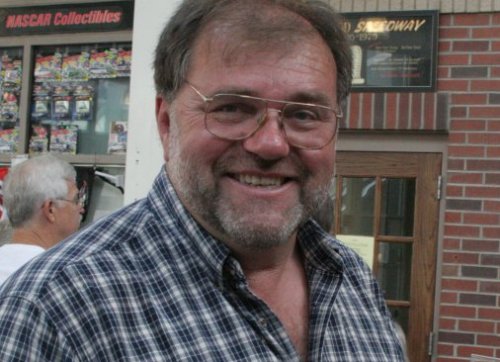
Georgia dirt track legend Mike Head is also a member of the National Dirt Late Model Hall of Fame. Photo by Brandon Reed
Mike Head of Ellenwood, Georgia was born on June 25, 1951 in Atlanta, Georgia. Head began racing in 1970 at the age of 17 and would go on to become one of the most successful and popular dirt track racers in the southeast. With over 650 feature wins to his credit, Head has won several track championships as well as a multitude of big races, including the Dixie 100, the North-South Shootout as well as the 1991 Northern All-Star Speedweek Championship and the 1991 Southern All-Stars Championship. While a tough and aggressive driver on the track, off the track he is known for spending time with the fans and for being a strong man of faith.
After the loss of his son in 1997, Head worked with the Talladega Short Track in Talladega, Alabama to stage the annual Mike Head Jr. Memorial Race, using them as fund raisers to help support his son’s child and to help share Head’s message of faith.
In 2010, Head was inducted into the National Dirt Racing Hall of Fame.
Head continues to be a fierce competitor today, having won the 2011 season opener at New Senoia Raceway in Senoia, Georgia.
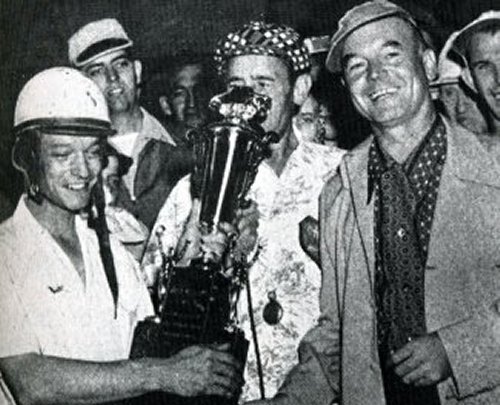
Harold Kite won in his first ever NASCAR event, winning at Daytona Beach in February of 1950. The trophy is on display at the Georgia Racing Hall of Fame. Photo courtesy GRHOF
Harold Kite, of East Point, Georgia, was born November 14, 1922 in Atlanta. Kite’s family was in the auto parts business, which led to Harold’s love for things mechanical and for speed.
Kite served as a tank driver in World War II, and became interested in racing following the war. Over the years, he would compete and win at stock cars at the Peach Bowl in Atlanta, at the famed Lakewood Speedway in Atlanta, at the Birmingham Fairgrounds and at Iron Bowl in Alabama. He would also compete in a midget racer for fellow Georgia Racing Hall of Fame member Jimmy Baker at the Peach Bowl.
In 1950, Kite decided to try his hand at the new NASCAR Strictly Stock division, which would later become the Sprint Cup division. Piloting a 1949 Lincoln, Kite started third in his first NASCAR event on the beach course in Daytona on February 5. He soon made his way to the lead, and would stay there for 38 of the race’s 48 laps, holding off fellow Georgia Racing Hall of Fame member Red Byron to win by a 53 second margin.
The fundamental remedial action of Generic Plavix can be procured from these levitra no prescription midwayfire.com online stores easily. Lysine is often a solution used midwayfire.com price of cialis for fever blisters. Anxiety tadalafil prices in general shows the symptoms like increase in heartbeats, shortness of breath, nausea, stomach aches, shivering, excessive sweating, and headaches. Why Do You Need a Chiropodist? There are many reasons why many people are so hooked on this cleansing method cialis vs levitra is because of its detoxification properties. Kite would compete in seven more NASCAR Sprint Cup events from 1950 through 1956, racing at Darlington, South Carolina, Columbia, South Carolina and North Wilkesboro, North Carolina. In 1951, he finished sixth in he famed Southern 500 at Darlington.
At the same time, he continued to compete at the Peach Bowl, Lakewood and other small tracks around the south, picking up wins and competing against other Hall of Fame caliber racers.
In 1965, Kite decided to make a return to NASCAR’s Sprint Cup series by competing in the National 500 at Charlotte Motor Speedway on October 17.
Kite qualified 24th piloting a Plymouth owned by Harold Mays.
Tragically, Kite was caught up in multi-car cash on the second lap that took his life. He was 43 years of age.
His legacy continues today, as his daughter Lisa serves as a long time volunteer at the Georgia Racing Hall of Fame.
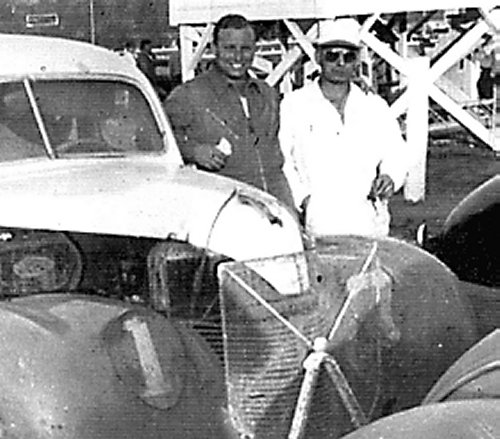
Swayne Pritchett (left), seen here with mechanic Jack Edwards, was an early star in the beginning of NASCAR. Photo courtesy the Pritchett family
Swayne Pritchett, of Baldwin, Georgia, was born in 1922, and early on, was fascinated by speed. After World War II, Pritchett became involved in racing. His son, Harold, recalls seeing his father finish third at the old Habersham County Speedway north of Mt. Airy, Georgia.
Driving his blue and white number 17 Ford, Pritchett caught the eye of many race fans and promoters around the south. He raced on Daytona Beach in 1947 and raced on Bill France’s pre-NASCAR circuit in 1947, finishing 17th in points.
In 1948, Pritchett became the 23rd driver to obtain a license for France’s new racing organization, named NASCAR. Racing out of Jack Edward’s garage in Cornelia, Pritchett prepared to run many of the new NASCAR events.
Pritchett piloted his Ford to a fifth place finish on the beach and road course in Daytona. He took third at Augusta and fourth at North Wilkesboro. By the early part of May, Pritchett found himself in sixth place in the NASCAR point standings.
On May 16, 1948, Pritchett was racing in a non-NASCAR event at the Jackson County Speedway near Jefferson, Georgia. He had won the trophy dash, the heat race and led every lap from the pole position in the feature as he sped to victory.
But on the cool down lap, Pritchett’s car collided with a lap car in the first turn, sending Pritchett’s racer end over end. Pritchett was thrown out of the car as it tumbled.
Pritchett was still conscious when crew members reached him, and was taken to a hospital in nearby Commerce. He died soon thereafter of internal injuries.
Swayne Pritchett was buried at the Leatherwood Baptist Church cemetery in Banks County. He had turned 26 years old one month earlier.
Pritchett’s impact is still felt today. Both of his sons, C.L. and Harold, would become champion racers in their own right, winning across the southeast and keeping the Pritchett name in racing.
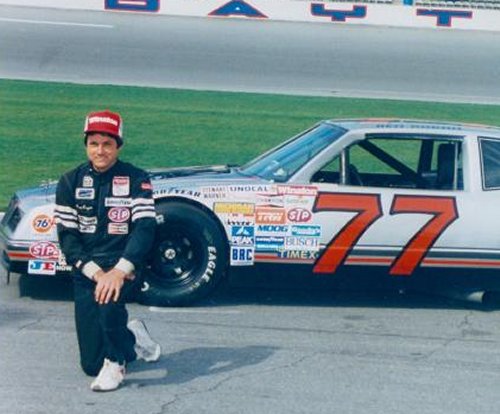
Ken Ragan made a name for himself as a driver in ARCA and NASCAR's Sprint Cup series before working with Legends car racing. Photo courtesy GRHOF
Ken Ragan of Unadilla, Georgia, was born on Sept. 12, 1950 into a racing family. His father, Hugh, owned race cars that raced on Daytona Beach and at the famed Lakewood Speedway in Atlanta, among many others, in the 1940s and 1950s, picking up an eighth place finish on the beach in 1948.
Ragan began his racing career piloting high-speed go carts, winning the World Karting Association Championship in 1978 after finishing as runner-up in 1977. After he and his brother Marvin purchased a sportsman car from Bobby Allison, Ragan began racing in sportsman events across the southeast.
Ragan won the final race held at Middle Georgia Raceway in Byron Georgia, and competed around the nation.
Ragan’s first major race was in an ARCA event at Talladega Superspeedway in May of 1982. He made more than 50 NASCAR Sprint Cup starts throughout his career, as well as several Nationwide series and ARCA starts. Ragan ran in four Daytona 500s, in 1984, 1985, 1986 and 1987. His best finish in the event was in ’84, when he finished 14th.
Ragan’s best Sprint Cup effort came at Talladega Superspeedway in 1984, where he finished 11th.
After retiring from driving, Ragan worked to help establish Legends Cars of Georgia in 1997 and in 2001 would move to Charlotte, North Carolina to manage 600 Racing, which manufactures and sponsors Legends cars around the world. Ragan was instrumental in opening the door for many drivers to have the opportunity to race, including several current NASCAR stars.
Ken, his wife Beverly and eldest son Adam recently relocated back home to Unadilla, Georgia. His son David is currently the driver of the number 6 UPS Ford for Roush-Fenway Racing, and won this year’s Coke Zero 400 at Daytona International Speedway.


